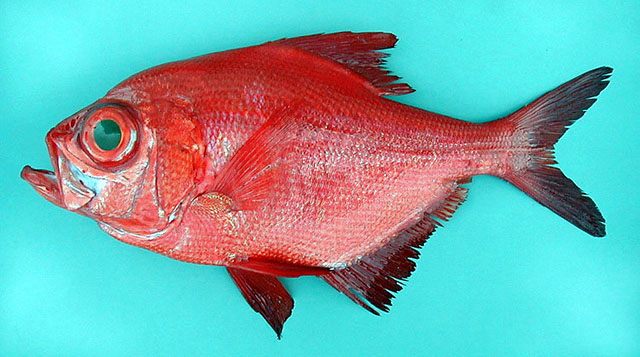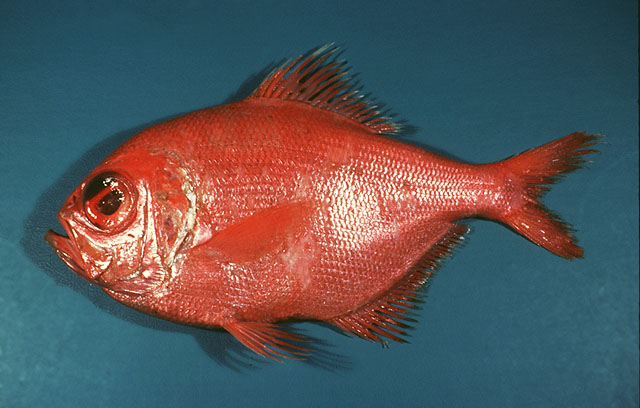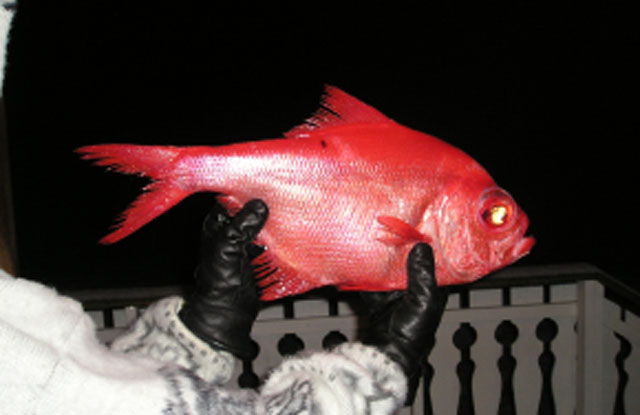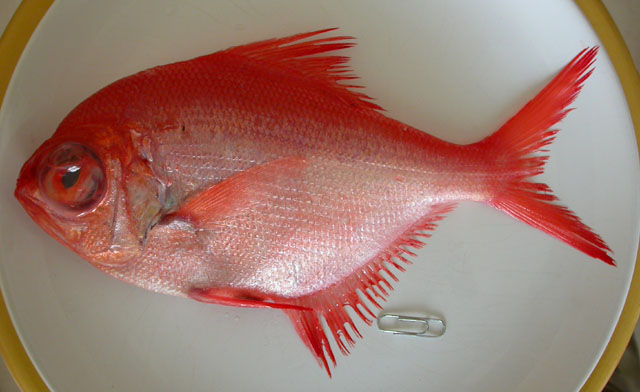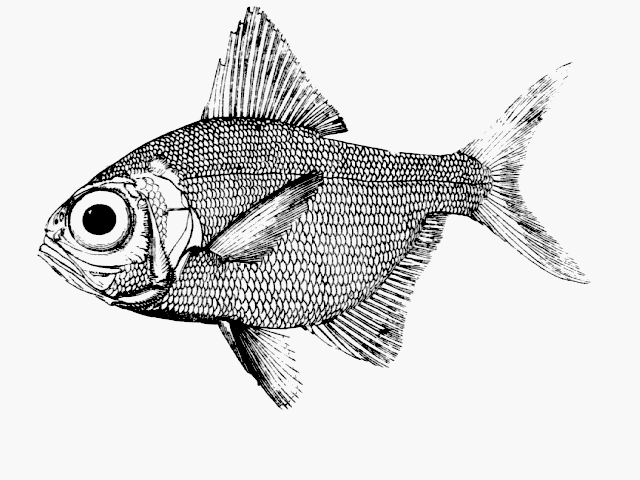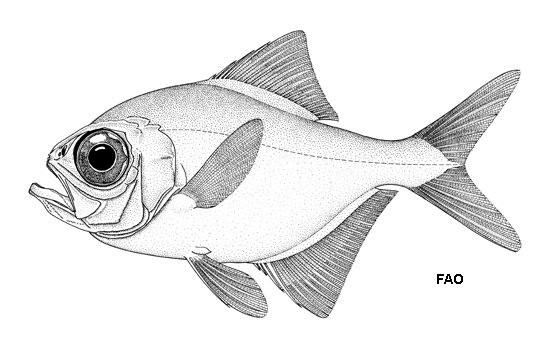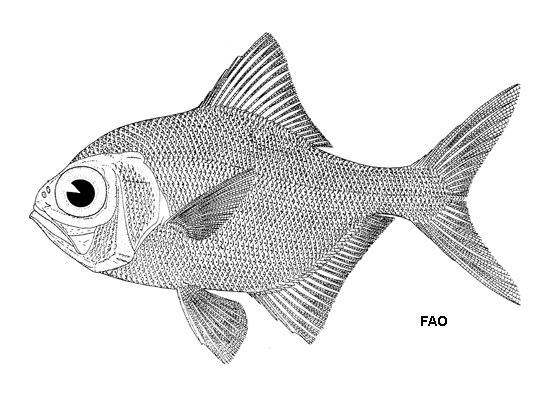Beryx
decadactylus
Cuvier,
1829
Alfonsino
View all media / Upload your photos and videos
Expand all
Classification / Names
Teleostei (teleosts) > Beryciformes (Sawbellies) >
Berycidae (Alfonsinos)
Etymology: Beryx: Greek, beryx or berys = a name of a fish. Cuvier & Valenciennes (1829:221) precise that the name was used by Gesner from Varinus, but with no indication whatsoever helping identifying any species. After D'Arcy Wentworth Thompson (A glossary of Greek fishes, 1947), the name actually seems to come originally from Hesychius, but perhaps the name was not originally a fish name. Thompson compares it to meryx (ruminant), applied on skaros (Scarus), so it may have been applied on a parrot fish referring to its browsing/grazing behavior described by Aristoteles and followers.
More on author:
Cuvier.
Environment / milieu / depth range / climate zone / distribution range
Distribution
Worldwide in temperate and tropical latitudes, except the eastern Pacific. Eastern Atlantic: Greenland, Iceland, and Norway to Western Sahara and South Africa, including western Mediterranean. Western Atlantic: south to Brazil. Also found in Argentine (Ref. 2806). Indo-Pacific: East Africa (including the Madascar Ridge and Saya de Malha Bank, Ref. 33390) to Japan, Australia, and New Zealand (Ref. 5755). The limited number of records in the western Pacific is doubtless the result of limited fishing effort below 200 m (Ref. 9833).
Maps

Beryx decadactylus / Native range
AquaMaps Data sources:
GBIF
OBIS
This map was computer-generated and has not yet been reviewed.

Beryx decadactylus / Suitable habitat
AquaMaps Data sources:
GBIF
OBIS
This map was computer-generated and has not yet been reviewed.

Beryx decadactylus / Point map
AquaMaps Data sources:
GBIF
OBIS
This map was computer-generated and has not yet been reviewed.

Beryx decadactylus / Year 2050
AquaMaps Data sources:
GBIF
OBIS
This map was computer-generated and has not yet been reviewed.
Length at first maturity / Size / Weight / Age
Short description
Dorsal spines (total): 4; Dorsal soft rays (total): 18 - 20; Anal spines: 4; Anal soft rays: 25 - 30. Body deep, compressed and has a large eye. Top of head, iris, back and all fins bright blood red. Orbital bones, cheeks and opercular bones shiny white. Breast shiny yellowish white. Body silvery with thin lengthwise lines (Ref. 37108).
Biology
Found in ca. 500 m on mud or sandy mud bottom (Ref. 11230). Occurs on the continental slope; adults demersal, young pelagic (Ref. 9563). Feeds on crustaceans, small fishes and cephalopods (Ref. 3321). A 35 cm SL specimen was found in the stomach of Latimeria (Ref. 58472). Young have heavy spines on the head (Ref. 35388).
Main reference
Maul, G.E. 1990 Berycidae. p. 626. In J.C. Quero, J.C. Hureau, C. Karrer, A. Post and L. Saldanha (eds.) Check-list of the fishes of the eastern tropical Atlantic (CLOFETA). JNICT, Lisbon; SEI, Paris; and UNESCO, Paris. Vol. 2. (Ref. 7413)
IUCN Red List Status (Ref. 125652)
Least Concern (LC); date assessed: January 29 2013
CITES (Ref. 131153)
Not Evaluated
CMS (Ref. 116361)
Not Evaluated
Threat to humans
Harmless
More information
- Countries
- FAO areas
- Ecosystems
- Occurrences
- Introductions
- Stocks
- Ecology
- Diet
- Food items
- Food consumption
- Ration
- Common names
- Synonyms
- Metabolism
- Predators
- Ecotoxicology
- Reproduction
- Maturity
- Spawning
- Spawning aggregation
- Fecundity
- Eggs
- Egg development
- Age/Size
- Growth
- Length-weight
- Length-length
- Length-frequencies
- Morphometrics
- Morphology
- Larvae
- Larval dynamics
- Recruitment
- Abundance
- References
- Aquaculture
- Aquaculture profile
- Strains
- Genetics
- Allele frequencies
- Heritability
- Diseases
- Processing
- Mass conversion
- Vision
- Pictures
- Stamps, Coins Misc.
- Sounds
- Ciguatera
- Speed
- Swim. type
- Gill area
- Otoliths
- Brains
Estimates based on models
Preferred temperature (Ref. 123201): 4.5 - 18.3, mean 11.2 °C (based on 1031 cells).
Phylogenetic diversity index (Ref. 82804): PD50 = 0.626 [Uniqueness, from 0.5 = low to 2.0 = high].
Bayesian length-weight: a=0.01445 (0.00900 - 0.02322), b=3.05 (2.91 - 3.19), in cm total length, based on LWR estimates for this species & (Sub)family-body (Ref. 93245).
Trophic level (Ref. 69278): 4.1 ±0.8 se; Based on food items.
Resilience (Ref. 120179): Low, minimum population doubling time 4.5 - 14 years (K = 0.11-0.16; tmax >11).
Fishing vulnerability (Ref. 59153): High to very high vulnerability (69 of 100).
Climate vulnerability (Ref. 125649): High vulnerability (62 of 100).
Price category (Ref. 80766): Medium; Questionable: based on ex-vessel price for species in this genus.
Nutrients (Ref. 124155): Calcium = 12.8 [4.1, 39.6] mg/100g; Iron = 0.379 [0.162, 0.819] mg/100g; Protein = 17.2 [16.2, 18.3] %; Omega3 = 0.382 [0.155, 0.983] g/100g; Selenium = 22.9 [10.2, 51.9] μg/100g; VitaminA = 14 [3, 66] μg/100g; Zinc = 0.314 [0.209, 0.501] mg/100g (wet weight);

